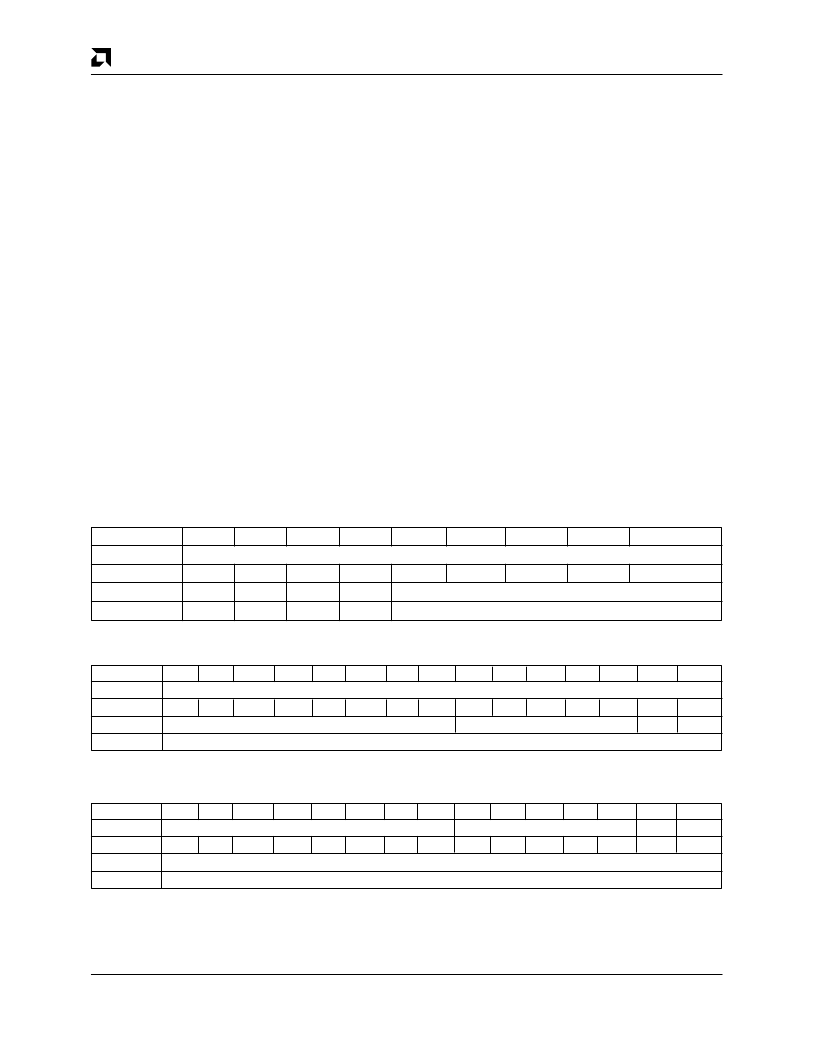- 您現(xiàn)在的位置:買賣IC網(wǎng) > PDF目錄366550 > AM79C970A (Advanced Micro Devices, Inc.) PCnet-PCI II Single-Chip Full-Duplex Ethernet Controller for PCI Local Bus Product PDF資料下載
參數(shù)資料
| 型號(hào): | AM79C970A |
| 廠商: | Advanced Micro Devices, Inc. |
| 英文描述: | PCnet-PCI II Single-Chip Full-Duplex Ethernet Controller for PCI Local Bus Product |
| 中文描述: | PCnet - 2的PCI單芯片全雙工以太網(wǎng)控制器,適用于PCI總線產(chǎn)品 |
| 文件頁(yè)數(shù): | 162/219頁(yè) |
| 文件大?。?/td> | 1065K |
| 代理商: | AM79C970A |
第1頁(yè)第2頁(yè)第3頁(yè)第4頁(yè)第5頁(yè)第6頁(yè)第7頁(yè)第8頁(yè)第9頁(yè)第10頁(yè)第11頁(yè)第12頁(yè)第13頁(yè)第14頁(yè)第15頁(yè)第16頁(yè)第17頁(yè)第18頁(yè)第19頁(yè)第20頁(yè)第21頁(yè)第22頁(yè)第23頁(yè)第24頁(yè)第25頁(yè)第26頁(yè)第27頁(yè)第28頁(yè)第29頁(yè)第30頁(yè)第31頁(yè)第32頁(yè)第33頁(yè)第34頁(yè)第35頁(yè)第36頁(yè)第37頁(yè)第38頁(yè)第39頁(yè)第40頁(yè)第41頁(yè)第42頁(yè)第43頁(yè)第44頁(yè)第45頁(yè)第46頁(yè)第47頁(yè)第48頁(yè)第49頁(yè)第50頁(yè)第51頁(yè)第52頁(yè)第53頁(yè)第54頁(yè)第55頁(yè)第56頁(yè)第57頁(yè)第58頁(yè)第59頁(yè)第60頁(yè)第61頁(yè)第62頁(yè)第63頁(yè)第64頁(yè)第65頁(yè)第66頁(yè)第67頁(yè)第68頁(yè)第69頁(yè)第70頁(yè)第71頁(yè)第72頁(yè)第73頁(yè)第74頁(yè)第75頁(yè)第76頁(yè)第77頁(yè)第78頁(yè)第79頁(yè)第80頁(yè)第81頁(yè)第82頁(yè)第83頁(yè)第84頁(yè)第85頁(yè)第86頁(yè)第87頁(yè)第88頁(yè)第89頁(yè)第90頁(yè)第91頁(yè)第92頁(yè)第93頁(yè)第94頁(yè)第95頁(yè)第96頁(yè)第97頁(yè)第98頁(yè)第99頁(yè)第100頁(yè)第101頁(yè)第102頁(yè)第103頁(yè)第104頁(yè)第105頁(yè)第106頁(yè)第107頁(yè)第108頁(yè)第109頁(yè)第110頁(yè)第111頁(yè)第112頁(yè)第113頁(yè)第114頁(yè)第115頁(yè)第116頁(yè)第117頁(yè)第118頁(yè)第119頁(yè)第120頁(yè)第121頁(yè)第122頁(yè)第123頁(yè)第124頁(yè)第125頁(yè)第126頁(yè)第127頁(yè)第128頁(yè)第129頁(yè)第130頁(yè)第131頁(yè)第132頁(yè)第133頁(yè)第134頁(yè)第135頁(yè)第136頁(yè)第137頁(yè)第138頁(yè)第139頁(yè)第140頁(yè)第141頁(yè)第142頁(yè)第143頁(yè)第144頁(yè)第145頁(yè)第146頁(yè)第147頁(yè)第148頁(yè)第149頁(yè)第150頁(yè)第151頁(yè)第152頁(yè)第153頁(yè)第154頁(yè)第155頁(yè)第156頁(yè)第157頁(yè)第158頁(yè)第159頁(yè)第160頁(yè)第161頁(yè)當(dāng)前第162頁(yè)第163頁(yè)第164頁(yè)第165頁(yè)第166頁(yè)第167頁(yè)第168頁(yè)第169頁(yè)第170頁(yè)第171頁(yè)第172頁(yè)第173頁(yè)第174頁(yè)第175頁(yè)第176頁(yè)第177頁(yè)第178頁(yè)第179頁(yè)第180頁(yè)第181頁(yè)第182頁(yè)第183頁(yè)第184頁(yè)第185頁(yè)第186頁(yè)第187頁(yè)第188頁(yè)第189頁(yè)第190頁(yè)第191頁(yè)第192頁(yè)第193頁(yè)第194頁(yè)第195頁(yè)第196頁(yè)第197頁(yè)第198頁(yè)第199頁(yè)第200頁(yè)第201頁(yè)第202頁(yè)第203頁(yè)第204頁(yè)第205頁(yè)第206頁(yè)第207頁(yè)第208頁(yè)第209頁(yè)第210頁(yè)第211頁(yè)第212頁(yè)第213頁(yè)第214頁(yè)第215頁(yè)第216頁(yè)第217頁(yè)第218頁(yè)第219頁(yè)

AMD
P R E L I M I N A R Y
162
Am79C970A
A logical address is passed through the CRC generator,
producing a 32 bit result. The high order 6 bits of the
CRC is used to select one of the 64 bit positions in the
Logical Address Filter. If the selected filter bit is set,
the address is accepted and the frame is placed
into memory.
The Logical Address Filter is used in multicast address-
ing schemes. The acceptance of the incoming frame
based on the filter value indicates that the message may
be intended for the node. It is the node’s responsibility to
determine if the message is actually intended for the
node by comparing the destination address of the stored
message with a list of acceptable logical addresses.
If the Logical Address Filter is loaded with all ZEROs
and promiscuous mode is disabled, all incoming logical
addresses except broadcast will be rejected.
PADR
This 48-bit value represents the unique node address
assigned by the ISO 8802-3 (IEEE/ANSI 802.3) and
used for internal address comparison. PADR[0] is com-
pared with the first bit in the destination address of the
incoming frame. It must be ZERO since only the destina-
tion address of a unicast frames is compared to PADR.
The six hex-digit nomenclature used by the ISO 8802-3
(IEEE/ANSI 802.3) maps to the PCnet-PCI II controller
PADR register as follows: the first byte is compared with
PADR[7:0], with PADR[0] being the least significant bit
of the byte. The second ISO 8802-3 (IEEE/ANSI 802.3)
byte is compared with PADR[15:8], again from the least
significant bit to the most significant bit, and so on. The
sixth byte is compared with PADR[47:40], the least sig-
nificant bit being PADR[40].
MODE
The mode register field of the initialization block is cop-
ied into CSR15 and interpreted according to the descrip-
tion of CSR15.
Receive Descriptors
When SWSTYLE (BCR20, bits 7–0) is set to ZERO,
then the software structures are defined to be 16
bits wide, and receive descriptors, (CRDA = Current
Receive Descriptor Address), are as shown in Table 40.
When SWSTYLE (BCR 20, bits 7–0) is set to ONE or
TWO, then the software structures are defined to be 32
bits wide, and receive descriptors, (CRDA = Current
Receive Descriptor Address), are as shown in Table 41.
When SWSTYLE (BCR 20, bits 7–0) is set to THREE,
then the software structures are defined to be 32 bits
wide, and receive descriptors, (CRDA = Current Re-
ceive Descriptor Address), are as shown in Table 42.
Table 40. Receive Descriptor (SWSTYLE = 0)
Address
CRDA+00h
CRDA+02h
CRDA+04h
CRDA+06h
15
14
13
12
11
RBADR[15:0]
CRC
10
9
8
7–0
OWN
1
0
ERR
1
0
FRAM
1
0
OFLO
1
0
BUFF
STP
ENP
RBADR[23:16]
BCNT
MCNT
Table 41. Receive Descriptor (SWSTYLE = 1,2)
Address
31
30
29
28
27
26
25
24
23
22
21
20
19–16
15–12
11–0
CRDA+00h
RBADR[31:0]
CRDA+04h
OWN
ERR
FRAM
OFLO
CRC
BUFF
STP
ENP
BPE
PAM
LAFM
BAM
RES
1111
BCNT
CRDA+08h
RCC
RPC
0000
MCNT
CRDA+0Ch
RESERVED
Table 42. Receive Descriptor (SWSTYLE = 3)
Address
31
30
29
28
27
26
25
24
23
22
21
20
19–16
15–12
11–0
CRDA+00h
RCC
RPC
0000
MCNT
CRDA+04h
OWN
ERR
FRAM
OFLO
CRC
BUFF
STP
ENP
BPE
PAM
LAFM
BAM
RES
1111
BCNT
CRDA+08h
RBADR[31:0]
CRDA+0Ch
RESERVED
相關(guān)PDF資料 |
PDF描述 |
|---|---|
| AM79C970AVCW | PCnet-PCI II Single-Chip Full-Duplex Ethernet Controller for PCI Local Bus Product |
| AM79C970 | PCnetTM-PCI Single-Chip Ethernet Controller for PCI Local Bus |
| AM79C971VCW | PCnet⑩-FAST Single-Chip Full-Duplex 10/100 Mbps Ethernet Controller for PCI Local Bus |
| AM79C971 | PCnet⑩-FAST Single-Chip Full-Duplex 10/100 Mbps Ethernet Controller for PCI Local Bus |
| AM79C971KCW | IC LOGIC 16211 24-BIT FET BUS SWITCH -40+85C TSSOP-56 35/TUBE |
相關(guān)代理商/技術(shù)參數(shù) |
參數(shù)描述 |
|---|---|
| AM79C970AKC | 制造商:AMD 制造商全稱:Advanced Micro Devices 功能描述:PCnet-PCI II Single-Chip Full-Duplex Ethernet Controller for PCI Local Bus Product |
| AM79C970AKC\\W | 制造商:Rochester Electronics LLC 功能描述:- Bulk 制造商:Advanced Micro Devices 功能描述: |
| AM79C970AKC\W | 制造商:Rochester Electronics LLC 功能描述:- Bulk |
| AM79C970AKCW | 制造商:AMD 制造商全稱:Advanced Micro Devices 功能描述:PCnet-PCI II Single-Chip Full-Duplex Ethernet Controller for PCI Local Bus Product |
發(fā)布緊急采購(gòu),3分鐘左右您將得到回復(fù)。